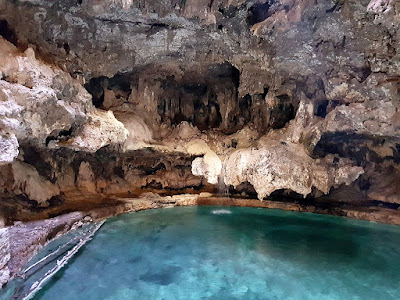311 Cave Avenue, Banff, Alberta, Canada
Daily: 9.30am - 5.00pm (17 May - 14 Oct)
Wed-Sun: 11.00am - 5.00pm (Other times)
Cave and Basin is a site of natural thermal mineral springs around which Banff National Park, which is Canada's oldest national park, was established in 1885. Said to be the birthplace of the national parks in Canada, it's the lowest component of nine sulfurous hot springs of Sulphur Mountain.

To go to Cave and Basin, my BFF and I took Roam Bus #4 from Marmot Crescent near
Inns of Banff.
In less than 15 minutes, we reached the site.
 |
| There's a gift shop near the bus stop. |
 |
| It's a sign showing the distances of other national parks and heritage sites. |
From the gift shop, you need to walk a short distance of 150 m to reach the entrance to the museum.
 |
| If you have the time, you may want to trek to Sundance Canyon. |
Similar to
Banff Park Museum, the entrance fee is
C$3.90 (~S$4.05) per adult. Children below the age of 18 need not pay to enter the museum. Should you wish to visit both Cave and Basin and Banff Upper Hot Springs all the way to the south of Mountain Avenue as well, you may want to get a Thermal Waters Pass that costs
C$11.35 (~S$11.65).
The first recorded reference to the Sulphur Mountain hot springs is by James Hector of The British North American Exploring Expedition called Palliser Expedition in 1859, followed by Joe Healey in 1874 who specifically found the Cave and Basin site in 1875.
 |
However, it was two Canadian Pacific Railway workers, Frank McCabe and William McCardell,
together with the brother of the latter who brought national attention to the Cave and Basin site. |
 |
| Dancers at Stoney Nakoda Family Camp, Banff National Park, 2012 |
 |
| It's a cross-section of a microbial mat, which is a multi-layered sheet of microorganisms. |
There's a bigger hall with screens showing some video clips, part of which used to be the former changing room when a naturally heated swimming pool was in operation.
 |
| The purple colour must be due to the presence of manganate(VII) ions. |
 |
| There are 13 points under the swimming pool regulations. |
There are panels that tell stories of the different eras from 1885 to the present day.
 |
| The Lure of the Lucrative Mountains (1885-1910) |
 |
| New Horizons for Parks (1911-1935) |
 |
| Playground and Refuges (1936-1964) |
 |
| Parks and Partnerships (1965-present) |
 |
| 'Elk Story Hide' by Radford Blackrider |
Share your imagination your dream country!
 |
| Write, take a photo and get it printed, then put it up on the wall! |
You can see the outline of the outdoor swimming pool that used to operate for 80 years from 1914 to 1994.
 |
| Mountain goats~ |
There's a building named after David Drummond Galletly, one of Parks Canada's first interpreters who hailed from Scotland.
 |
| There's a multi-purpose room that can comfortably accommodate 40 seats. |
 |
| Snakes and snails, not ladders! |
 |
| Such a classic poster-like design! |
Look at the beautiful colours of the outdoor hot spring.
 |
| There's a rare snail species that can only be found in hot springs of Sulphur Mountain. |
Take a look at the rising small bubbles in the video clip below.
Near the hot spring is a boardwalk with information on climate change and efforts to combat it.
 |
| Tennis ball-sized hails collected after an extreme storm at Saskatchewan Prairies! |
 |
| How committed are you in fighting against climate change? |
Subsequently, we went through the man-made tunnel leading to the small cave with a hot spring.
 |
| Natural light at the end of the tunnel~ |
 |
| The sulfur smell inside the cave isn't too bad. |
I took a short video clip inside the cave.
Before leaving the site, we enjoyed the view of the scenery.
If you're serious about visiting the various national parks and historic sites across Canada, you may want to invest in Parks Canada Discovery Pass that ofers unlimited admission to over 80 places for a duration of 12 months. It costs C$67.70 (~S$69.55) per adult.





























































































































Comments
Post a Comment